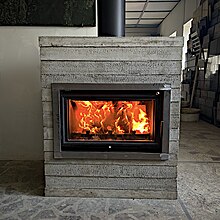Fireplace insert
This article has multiple issues. Please help improve it or discuss these issues on the talk page. (Learn how and when to remove these messages)
|

A fireplace insert is a device that can be inserted into an existing masonry or prefabricated wood fireplace. Most fireplace inserts are made from cast iron or steel. Fresh air enters through vents below, circulates around the main chamber (where it heats up), then exits through the chimney. Fireplace inserts have insulated glass doors that allow the fire to be viewed while closed, improving fuel efficiency and heat output.[1] Air is directed across the interior surface of the glass to prevent the buildup of ash.
Fireplace inserts are categorized primarily by the type of fuel used (natural gas, propane, EPA-certified wood, pellet, coal or electric).
History
The fireplace insert was invented in 1896 by Joab R. Donaldson of Oliphant Furnace, Pennsylvania, United States.[2] Joab was a 59-year-old coal miner and father of 14 at the time of his patent. He came upon the idea as a means of using coke (a smokeless fuel made by the destructive distillation of certain types of coal) and incorporating the use of an electric blower to improve the efficiency. The selection of coke and coal tailings as a primary fuel enabled low-income families to heat their Appalachian homes with small-size coal that they could easily dig for themselves in their own backyards.
Electric fireplace inserts
Electric fireplace inserts are made to fit any size of a brick or steel-covered hearth. Plug-in electric fireplace inserts typically connect to a common 120-volt wall plug and are placed within an existing fireplace.
Electric fireplace inserts come in three form factors:
- Electric log inserts (which imitate a natural wood flame)
- Plug-in inserts
- Built-in units

See also
References
- ^ "A fireplace insert can help ensure that your heat doesn't go up the chimney". Washington Post. 2022-02-11. ISSN 0190-8286. Retrieved 2024-10-10.
- ^ Joab R. Donaldson (1896) "Fireplace" U.S. patent 000,561,871
